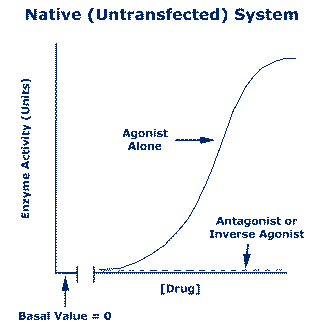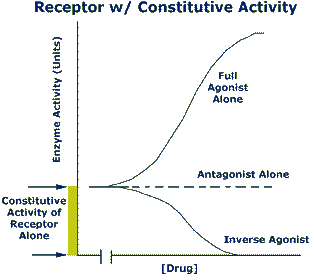Inverse Agonists:
Simple Two State Model of Receptor
Activation:
When an agonist
binds to a cell surface receptor, it produces a conformational change in the receptor that in turn induces series of events
that result in a measurable response. The physical characteristics of the agonist molecule make the needed conformational
change in the receptor much more likely than in the absence of agonist. However, this conformational change is probably
also occurring by random chance in the absence of agonist simply as a result of the kinetic motion of the receptor.
However, this conformation is so infrequently attained without agonist that we usually can’t measure such a response.
Thus in classical systems the response in the absence of agonist is usually 0. See the table for an illustration
of these points.
|

|
Figure
1. In the top equation, we see the usual situation of receptor activity. Activated receptor conformation (R*)
is needed to produce an effect. In the absence of agonist, this conformation is scarce. When agonist is present,
the receptor is much more likely to convert to an active conformation and the equilibrium shifts toward AR*. |
Constitutive
Activity
In transfected
systems (i.e., when the receptor gene is artificially expressed at 100-10,000 fold higher than normal) the absolute number
(but not the percentage) of receptors randomly assuming an active conformation without agonist is much higher than in native
cell populations. Thus sometimes when you attempt to measure a response in your transfected system, there is already
a considerable response in the absence of any added agonist. Those receptors producing a response without agonist are
said to be constitutively active. When you add agonist you get a response, as in the untransfected system. However,
when you add known antagonists of this receptor (in the absence of agonist), some antagonists produce no effect (intrinsic
activity = 0). However, some antagonists cause an inhibition of the constitutive activity of the receptor (see figure),
suggesting that this latter class of drugs are not technically antagonists but are agonists with a negative intrinsic activity.
Thus these drugs are called inverse agonists.
|

|
Figure
2. This example shows a concentration-response curve for activation of an enzyme by our receptor of interest.
In the native system, which has few constitutively active receptors, the basal (i.e. no agonist) activity is zero. Addition
of agonist alone produces a classical concentration-response. Addition of antagonists or inverse agonists alone will
produce no response since basal activity is already zero. |
|

|
Figure 3. When we examine a transfected system, basal activity is a measurable amount since there is a 1000
fold higher number of receptors compared to the native system. This means that there are 1000 times as many receptors
that randomly assume the active conformation vs. native cells. Thus, constitutive receptor activity is measurable in
the absence of agonist. In this case, addition of agonist alone also produces a classical concentration-response.
Addition of antagonist alone will produce no response. Addition of the inverse agonist stabilizes the inactive conformation
of the receptor and drives the equilibrium away from the active conformation. Thus addition of inverse agonist reduces
the constitutive activity of the receptor and inhibits basal activity. |
Frequently
Asked Questions about Inverse Agonists.
Problem: Why does the
drug inhibit the constitutive activity of the receptor?
Sol:
The receptor can be thought of as existing in an equilibrium between an inactive and an active form. Agonist bind and
make the active conformation much more likely. Inverse agonists probably bind to and stabilize the inactive form, which
pushes the equilibrium away from the spontaneous formation of the active conformation of the receptor.
Problem:
Why do we usually see this only in transfected systems?
Sol:
In classical systems, inverse agonists behave as antagonists with an intrinsic activity of 0. This is because the constitutive
activity of the receptor system in vivo is probably so small that no effect can be seen. It is the gross over expression
of the receptor population in transfected cells that makes the measurement of constitutive receptor activity (remember, without
agonist) possible.
Problem:
If this works only in transfected cells, then who cares?
Sol:
May be no one. However, there are two decent answers. First, there is some evidence of constitutively active receptor
systems in vivo. Surprisingly few receptor systems have been examined in great detail. One putative constitutively
active receptor is the benzodiazepine receptor, for which inverse agonists have tentatively been identified. Thus therapeutic
uses for inverse agonists may be just around the corner. Second, during the course of your careers, it is possible that
receptors will be transfected into patients to treat disease. It is possible that their activity will be fine-tuned
with inverse agonists.
